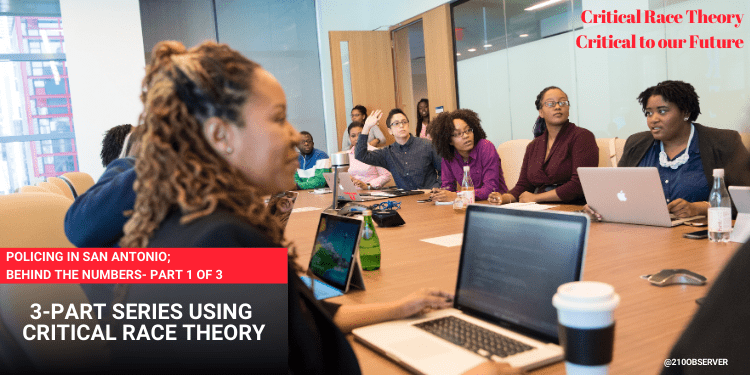San Antonio has an opportunity to distinguish itself from other cities on the list of top 10 most populous municipalities. If cries from civic leaders are to be believed, San Antonio could be the one municipality that improves race relations while keeping its police force intact. If you want to find out how that could happen you must read the entire three-part series of which this is the first. Today’s article will focus on the question; are blacks treated differently from whites in police encounters? There are two contradictory perspectives; the dominant white group believes that it is entitled to advantages and resources that are not readily available to non-dominant groups. They also support the institutions that were created to protect and serve their interests. Minority-group members often expect negative treatment in their encounters with police and may thus interpret an officer’s authoritarian demeanor as an instance of racial bias. Many blacks view the police as contributing to their subordination using both legal and illegal methods.
Both sides will be examined to provide a framework for resolving the stalemate.
In 2019, 406 white people were killed by police in the United States. The number of blacks killed by police during the same period was 259. The rate of police shootings of blacks is much higher than any other ethnicity, at 30 per million people. The rate for whites is 12 per million. The Texas Justice Initiative conducted a study of Officer-Involved Shootings and Custodial Deaths in Texas. As a result of this study it was revealed that more people have been shot and killed by law enforcement in Bexar County so far in 2020 than in 2019. This year, the San Antonio Police Department, the Bexar County Sheriff’s Office, the Balcones Heights Police Department and the Universal City Police Department have all reported a combined 19 officer-involved shootings, 11 of which were fatal. Last year, local agencies had combined for 20 shootings with 10 being lethal. When we explore the data from 2005 till 2019 1,172 people have died in the custody of law enforcement in Texas before being booked and 282 of those individuals, about 25 percent, were black. About 37 percent of the 1,172 people killed in these homicides were white, with Hispanics accounting for 34 percent. While substantial research has been devoted to bureaucratic justice at the local level, literature shows that other important factors also shape citizens’ opinions on policing: the historical legacy of policing, ecological factors, outcomes of encounters (distributive justice), media reporting on events, and information conveyed within social networks.
Individuals’ attitudes toward the police are partly based on their personal contacts with officers, and specifically whether they feel they were treated respectfully and fairly and provided with explanations for police actions. Such procedural justice during encounters influences not only how people assess the immediate situation but also how they view the police more generally. When a person is given no reason for being stopped, detained in public for a long time, subjected to arbitrary actions, verbally demeaned, or physically abused, it is almost guaranteed that he or she will define such actions as unjust; for many, the experience will also color their overall opinion of the police. The link between racial inequality and policing is reflected in a recent survey asking respondents whether they thought that “problems with race relations in our society cause police to treat minorities unjustly”: blacks overwhelmingly agreed with the statement, compared to less than a third of whites (see Table 1 below.
Table 1: Recent attitudes toward policing, by race (%)
| Blacks | Whites | Hispanics | |
| Not confident that police treat blacks and whites equally1 | 77 | 36 | 57 |
| Societal race relations cause unjust police treatment of minorities2 | 71 | 30 | 57 |
| Police killings of blacks s serious problem3 | 73 | 24 | 45 |
| Police killings: isolated incidents4 | 18 | 60 | 45 |
| Police killings: sign of broader problem | 74 | 35 | 51 |
| Altercations due to citizen resistance | 19 | 60 | N/A |
| Altercations due to police misconduct5 | 68 | 28 | N/A |
| Police departments treat misconduct leniently6 | 70 | 27 | N/A |
| CJ system treats violent officers leniently7 | 70 | 32 | N/A |
| Too much media attention to police misconduct | 13 | 52 | 33 |
| Not enough media attention to police misconduct8 | 48 | 17 | 26 |
| Media coverage of police biased in their favor | 45 | 18 | 29 |
| Media coverage of police biased against them9 | 13 | 54 | 26 |
- How confident are you that police treat blacks and whites equally (Washington Post, 2014).
- Problems with race relations in our society cause police to treat minorities unjustly (AP/NORC, 2015).
- Police killings of blacks are a serious problem in the United States (BYP, 2016).
- Police killings of unarmed black men in Ferguson, Missouri and New York City are isolated incidents or a sign of broader problems (Washington Post, 2014).
- Bigger cause of violent encounters between people and police: people disrespecting police and not following orders or police treating law-abiding people like suspects and using force too often (Washington Post, 2015).
- Police departments do a poor job in holding officers accountable for misconduct (Pew Research Center, 2014).
- Officers who injure or kill civilians are treated too leniently by the criminal justice system (AP/NORC, 2015).
- Over the last year, do you think the media has given too much, about the right amount, or too little attention to police misconduct (YouGov, 2016).
- Do you think media coverage of stories involving law enforcement is more likely to be biased in favor of police officers, biased against police officers, or fair in the way police officers are represented (YouGov, 2016).
The position the police occupy in the minority world is only partly a result of what the police do in that world; more importantly, their position is a function of fundamental emotional judgements made by people subjected to pervasive deprivation and inequality. The root cause of minority-group relations with police is grounded in larger structures of inequality and in the convergence of interests between the dominant racial group and state institutions, with the police being the most “visible sign of majority domination”.
Are blacks treated differently from whites during police encounters? Numbers do not lie! Next week (part 2), the role of the police union and how it affects policing in the community!









